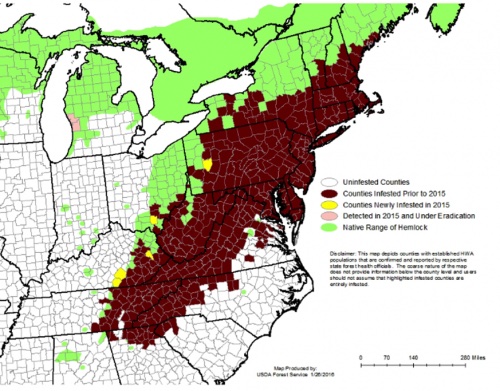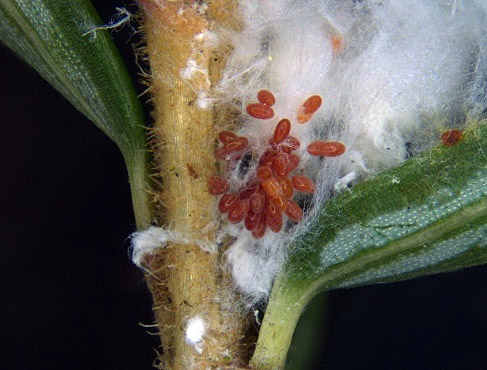Hemlock, What’s Buggin You?
by Carolyn R. Casey, Fairfax Master Gardener

Crawler stage
These bright sunny spring days gives one the opportunity to assess what is happening in the garden. While walking through my garden I noticed very small white cottony-looking balls on the lower ends of my hemlock branches just above and right at the ground level. Having not seen them before and doing some research I determined that this was a destructive insect named the hemlock woolly adelgid (Adelges tsugae) infesting my beautiful hemlocks.
The woolly adelgid is in the order Hemiptera and the family Adelgidae. It is native to Asia where it is a harmless inhabitant of several hemlock species. It was observed in North America in the 1920s on western hemlock. During the early 1950s the woolly adelgid were found in Virginia where they were consuming eastern hemlock and Carolina hemlock. They have now spread to most of the Appalachian region of the eastern United States and north into Canada. They are very small insects that experience distinctive forms during their life cycle. They have an oval shape that is 0.8 mm long and are usually a brownish reddish color.

Map showing extent of current range
On hemlocks, the hemlock woolly adelgid is parthenogenetic, that means, all individuals are females and capable of reproducing. Hemlock woolly adelgid populations develop quickly because the overwintering females may lay up to 300 eggs inside their white tuft. It is during the crawler stage that they create white cottony tufts.
These tufts are usually found on the underside of the hemlock tree branches. However, I have not only found the small white tufts on the underside of my hemlock branches but also on the tops of the branches. The tufts are present all year but are most visible from November to July when egg masses are present. The white woolly tufts enlarge as they feed. They use the tuft to cover their bodies and will stay in place throughout their lifetime. These white tufts may be 3 mm or more in diameter and can stay on the twig after the woolly adelgid dies.
Two generations of hemlock woolly adelgid are produced in an annual cycle. One is known as “sistens” and the other “progrediens.” The hemlock woolly adelgid completes two overlapping generations a year. Each generation will go through six life stages; these are egg, four nymphal instars and adult.
The woolly adelgid likes the cool weather and most of its developmental stages occur from October to June. However, when the temperature starts to warm up, the first instar nymphs of the “sistens” generation go into their dormant stage. The sisten nymphs break dormancy in October as temperatures start to get cool and during the winter develop into adults. The “sisten” adults will lay the “progrediens” eggs in February or March. The crawlers will hatch from April through May and then settle on the twigs near the bases of the needles where they insert their piercing and sucking mouthparts. There they feed on the hemlock throughout their development.
This spring generation matures by the middle of June and deposits an average of 75 eggs each. The crawlers hatch in early July and settle on the new growth. They are usually settled and dormant by the beginning of August. In mid-October, feeding resumes and the characteristic white woolly tuft covering begins to develop. Nymphs feed during the winter and mature by spring. Most of these eggs will become wingless adults that will stay on the hemlock tree and complete their life cycle. However, there are also winged woolly adelgid.
The immature nymphs and adult woolly adelgid damage hemlock trees by feeding on the storage cells near the base of the needles at the place where they attach on the twigs. This causes the hemlock tree to lose its vigor and prematurely drop its needles. Severely weakened hemlock trees are unsightly and have little chance for recovery. Weakened trees often fall victim to other insects and diseases and are easily broken by the wind. Once a tree becomes heavily infested, dieback of major limbs usually occurs within two years. This can lead to complete defoliation and the death of the hemlock. If not controlled, the woolly adelgid can kill a tree in four years.

Eggs
Even though the hemlock woolly adelgid spends its life attached to the hemlock branches, it is easily spread during the egg and crawler stages when they are not yet attached to the hemlock tree. They move from tree to tree by birds, wildlife, the wind and on gear, equipment, clothes, infected nursery stock and other hemlock materials. They are also moved when infested branches are pruned and disposed of and by vehicles or equipment that brush against infested branches.
Systemic insecticides allow for long term control of the hemlock woolly adelgid. Imidacloprid can be used as a soil drench in April or May. Other listed chemicals that can be used on the hemlock woolly adelgid are Dinotefuran, Potassium laurate, and Thiamethoxam. Keep in mind that the application of systemic pesticides may lead to the potential contamination of nectar and pollen collected by foraging honey bees. The use of neonicotinoid pesticides (e.g., clothianidin, imidacloprid, and thiamethoxam) is a concern for honey bee poisoning; although, there is a need for more research evidence.
Honey bees provide a valuable service to apiculture and agriculture not only because they produce honey and beeswax, but they are the most important pollinators of cultivated crops. Pesticide poisoning of honey bees and other beneficial insects can be a serious problem. Every effort should be made to minimize the exposure of honey bees to pesticides in treated areas.
You can treat your hemlocks any time with dormant oil although early November is the best time. The best compounds are horticultural oils which smother the insects. A 1 percent solution is recommended from May through September, and a 2 percent solution from October to April. Thoroughly wet the entire plant including the bark of branches and the trunk. Use a forceful spray and be sure the new growth is thoroughly wet. Dormant oil is also called horticultural oil. Always read and follow the directions on the label before using any systemic insecticides, dormant oil and all chemicals.
Cultural control includes the following: Discourage animal visits; monitor plant material movement from around your hemlock; clean vehicles, clothes, etc.; selectively remove heavily infested trees. Do not stress the plant. Prune out dead limbs; do not fertilize infested trees; use a stream of water to dislodge eggs and crawlers between April and June. Plant resistant species.
Fertilizing trees can end up causing more damage, as the extra nitrogen will make for more tender growth that will in-turn support more woolly adelgids. Only add fertilizer if it is suggested after a soil test.
Remember, when you are out working or walking in your garden, take the time to not only enjoy the beauty around you but to also to examine your plants to see what is going on with them and just what or who is visiting your garden. Through observation, identification and the use of preventative measures, ending invasion by the woolly adelgid can be performed in a timely manner allowing for the preservation and long life of your hemlocks for many years of enjoyment. Happy Gardening!
Resources
• Invasive Species: Hemlock Woolly Adelgid, State of Michigan
• Hemlock Woolly Adelgid Adelges tsugae (Annand), Maine Department of Agriculture, Conservation
& Forestry
• Hemlock Woolly Adelgid, Olivia Andrews, Virginia Cooperative Extension
• 2023 Pest Management Guide – Home Grounds and Animals, Virginia Cooperative Extension, EPA
Bee Advisory Box
